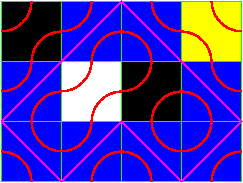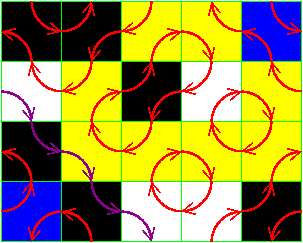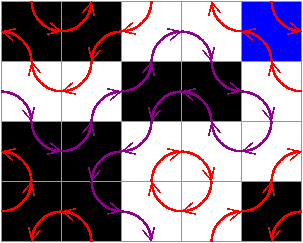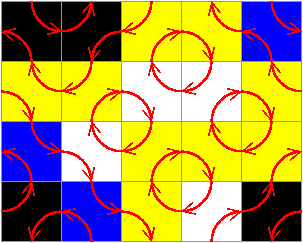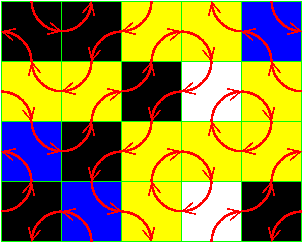An Alternate Model for
Langton's Ant:
Recall that the ant only has two options when he reaches a square:
turn left or right. Then he must leave the square. We can combine this
knowledge with our knowledge that the grid must be checkered to create
an alternate model for the Ant's movements:
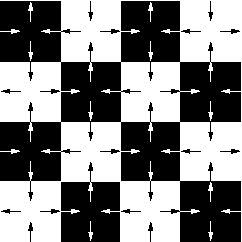
From the picture at right, it becomes obvious that the at each
quadrilateral of the grid, the ant can only come in two of the sides and
leave one of the two others (turning left or right). Its a question of
holonomy, the ant moves around in some path, and when he returns he is
facing one of two directions.
We replace a tile similar to:
with one of:
Replace this:
|
[0]: turn
left
Black
|
[1]:turn left
Blue
|
[2]:turn
right
White
|
[3]:turn
right
Yellow
|
With this:
|

|

|

|

|
The tiles increment exactly as before, here we use the color red, to
indicate that the tile will change the next time the Ant visits the
square, and black to indicate that the ant must return twice before the
tile changes. White tiles would be replaced similarly (ie: look at the
arrows not the checkering). Our starting position would then be "circles
around every other vertex of our grid."
One advantage of this model is that it makes the proof of symmetry and
returning to the origin infinitely often easier to prove. Here is the
idea:
- At any point in time our grid is covered by an infinite
family of closed paths, all but finitely many are circles around
vertices.
- There is a property we will call the Good Painter Property (GPP)
which we will state later.
- Our argument is inductive. The grid starts as a symmetric
grid with the GPP.
- Clearly any closed path in our grid can intersect each
square at most twice.
- If our grid has the GPP, then any path on the grid
intersects each red square at most once.
- Thus when our Ant moves around a path in a grid with the
GPP, it must return to the place it started (ie. its trajectory is
exactly the path it lies on). (What could go wrong? The only thing that
could wrong is the Ant visits a red square and then revisits it along
the same path, thus being redirected along a different path)
- If our grid is symmetric with the GPP and our Ant is
positioned along the axis of symmetry, the path our Ant will take will
be symmetric and thus when the ant returns to its original position
again the grid will regain its symmetry.
- We must show that if the GPP holds for our grid, the GPP
holds after the Ant moves all the way around a path in our grid. Then
the result will follow.
The fairy tale version of our argument is: The Ant is a good
painter. He starts with a good and symmetric canvas. Then he paints
layer upon layer of paint on his canvas never violating the rules he
learned which make him a good painter. His painting is good and
symmetric, and he continues to paint his painting making it better and
better and living happily ever after.
The Good Painter Property:
So what is the Good Painter Property?
The idea is that the "red" tiles, tiles of type [1] and [3], occur in
groups. You'll notice that the first time the Ant returns to the origin
(after making 4 left turns), the grid looks like this:

This is the simplest group. The
second simplest group consists of 6 squares (shown here for type [3],
yellow squares):
 |
or |
 |
Either white or black squares can
appear inside. Notice that in all these cases, the paths intersect
yellow/blue squares exactly once (this is the content of 5 above).

Vertices inherit a "checkering"
from the drawing above as well based on whether the closest arrows wind
clockwise or counter-clockwise around the vertex. The center of the blue
square in this picture corresponds to counter clockwise (the Ant turns
left on blue squares).

The condition that our grid has the
Good Painter Property (GPP) is that there is as a finite sum of properly
oriented 2-by-2 squares of type [1] which give us exactly all the type
[1] squares in our grid, and similarly there is as a finite
sum of properly oriented 2-by-2 squares of type [3] which
give us exactly all the type [3] squares in our grid. The GPP makes no
restriction on the occurance of type [0] or type [2] squares.
Now, given a grid with the GPP there are many different ways to
write a sum. Namely, two occurances of the same 2-by-2 square will
cancel. So one cannonical way to write a sum would be to require that
each 2-by-2 square occurs in the sum at most once. But this is not the
cannonical sum we will look at. We will require that our sum have the
following form:
- The number of occurances of a 2-by-2 square in the sum must
be equal, one less, or one more than adjacent 2-by-2 squares (adjacent
in the sense that their centers are located diagonally across a square
from one another)
- For all integers n,
let Sn be the set of all 2-by-2 squares
that occur more than n times in
the sum. We require that any loop in the adjacency graph of 2-by-2
squares contained in Sn has in its interior only
elements of Sn (a kind of simply connected
retriction on the level sets)
Condition 1 outlaws sums of the form: (numbers indicate the number
of occurances of the 2-by-2 square surrounding them)
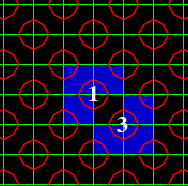
Condition 2 outlaws more
complicated pictures: (think of it as a mountain, as you move toward the
center you must step up never down into a valley)
Not
|
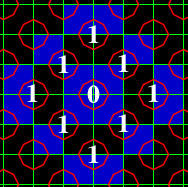
|
But
|

|
Now the boundary of each Sn forms an impenetrable fortress that
the curves do not pass through. That is curves on the interior stay on
the interior and curves on the exterior stay in the exterior. Moreover,
it can be seen that every blue (or yellow) square must lie on the
boundary of some Sn. This shows (5) of our proof
above, that curves in the a grid with the GPP intersect each square of
type [1] or [3] at most once.
Below shows a group of blue squares with the GPP and the "barrier"
seperating the inside and the outside in purple.
Proof of GPP persistence (and symmetry, returning of Ant):
It remains to show that the GPP persists through one complete loop.
The GPP turns out to be a natural property related to "always turning"
paths in a square grid. Consider a closed path in a square grid
which can be written as a sequence of right and left turns. We
also require that the path never overlap itself (but we do allow the
path to enter a square twice provided it neither enters nor leaves in
the same direction twice).
Then color the places where the curve turns once to the left with
our blue squares and the places that the curve turns once right with
yellow squares (ignore squares visited twice):
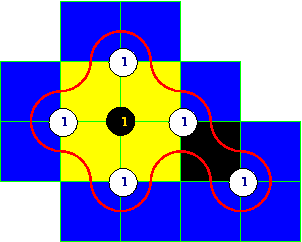
The yellow and the blue squares
satisfy the GPP. We can get the blue colored squares as a sum of all the
possible blue 2-by-2 squares with centers that lie on the interior of
our curve. Similarly we get the yellow squares. The proof is simple. Our
curve is a Jordan curve seperating the plane into two regions, thus on
when it crosses a particular blue square once exactly one of the
vertices on the diagonal transverse to the curve is on the interior.
Consequently, there is only one blue 2-by-2 square that is taken in our
sum that contains this particular square. Conversely if the curve hits a
particular square either twice or never, both relevant vertices must lie
on the same side of the curve, thus our sum of 2-by-2 squares cancels
over or does not contain this particular square. Similar for yellow
squares.
This gives us the simplest case of GPP persisting through a loop. Start
with an all [0] (black) grid, then sprinkle finitely many [2] (white)
squares randomly on the plane. This grid satifies the GPP because there
are no squares of type [1] or [3]. Now consider a closed path in
this grid, it looks like one we just described. After the Ant travels
the path, he modifies the grid exactly as we colored it above.
Consequently, this new grid also satisfies the GPP.
More generally if the grid satisfies the GPP, and the closed curve that
the Ant travels contains no squares of type [1] or [3], then after he
modifies the grid it also satisfies the GPP.
Next, we must deal with the possiblility that the curve may intersect
squares of type [1] and [3]. This argument is somewhat more subtle.
Recall that our curve cannot pass through the barriers seperating the
interiors and the exteriors of groups of squares of types [1] and
[3]. Recall also that each square of type [1] or [3] is contained
in the boundary of some Sn.The idea is to reduce
to the case we just proved by modifying the grid in some acceptable
manner, changing the curve to path admisable in this new grid, leading
the Ant along this new path, and then doing another acceptable
modification that returns the grid back into what the ant would have
done anyway. Then we argue that the presistence of the GPP is
obvious when looked at this way.
Lets do a simple example. Consider the purple curve in the picture
below (part of a greater closed curve not shown). It bumps the
yellow ([3]- right turns) group shown, and may concievably as we
continue outside the shown region return and bump the group yet again.
We modify the grid so that
- We modify the square in the group first bumped +1 (mod 4).
In this case the square first bumped of type [3] (yellow) becomes type
[0] black.
- The values of all the squares in the boundary of the clump
are decreased by 1 (mod 4). In this case changing squares of type [3]
(yellow) into squares of type [2] (white).
- We turn all the squares in the interior of the group to the
group's color +1 (mod 4). So in this case the two squares in the middle
become both black.
After modifying the grid in this way for each group bumped, we get
a new purple path which never crosses squares of type [1] or [3]:
Next we let the Ant modify this new path obtaining this grid,
which must satisfy the GPP by the argument before:
In the last step we replace the square where the group was first hit
and return the squares in what used to be the interior of the region to
there original types. Above the square first hit has become white (type
[2]) and we replace it by +2 (mod 4) to become black (type [0]). We
obtain this grid:
This is what the ant would have constructed had we not modified
the grid at all. The interior of the clump satisfied the GPP, and
besides this, we only replaces a square of type [2] with a square of
type [0], thus the GPP is satisfied in the whole resulting grid.
This argument shows the GPP persists through the ant moving around a
loop. There aren't to many modifications needed to show that this
argument works for general loops in a grid with the GPP. If you believe
this, we've proven that the ant returns to the square at which he starts
infinitely often and at these points the grid is symmetric.
This argument must be modified to suit deformed grids.
















